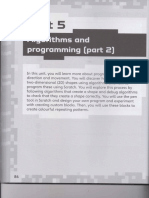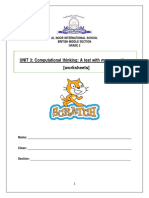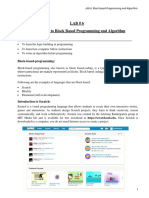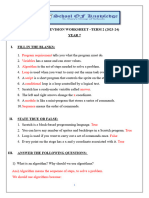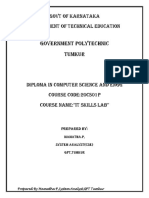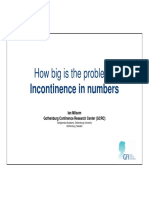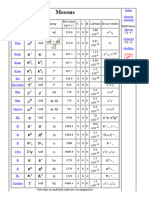AL NOOR INTERNATIONAL SCHOOL
GRADE 6 – ICT
UNIT 3 – Computational Thinking – Algorithms and Programs
Worksheet [1] – Scratch Introduction – 3.1, 3.2, 3.3
Name: _____________________ Class: ________ Date : ________________
Scratch Introduction:
I. Name the following.
1. ________________________: An object that performs actions in a
Scratch project.
2. ________________________: Main working area for Sprite.
3. ________________________: The place where all the instructions given
to the Sprite are arranged in stepwise manner.
4. ________________________: Default Sprite in Scratch.
5. ________________________: Set of instructions for the Sprite.
6. ________________________: A button which stops all the scripts in a
project immediately.
7. ________________________: A button which starts all the scripts with
an event when green flag clicked.
8. ________________________: A set of instructions given to the computer
to perform a task.
9. ________________________: A person who writes computer programs.
10. ________________________: A person who uses the program.
Page 1 of 10
� II. Write about arithmetic and relational operators used in Scratch.
[Use, symbol and name]
a. Arithmetic operators
What is the use? ______________________________________________
Symbol Name
b. Relational operators
What is the use? ______________________________________________
Symbol Name
III. Write the answer for the following.
1. : _____________________________
2. : _____________________________
Page 2 of 10
�3.1 A simple plan
I. Answer the following questions.
1. Answer the following questions based on the given algorithm.
a. What is the initial value of total? _________________________________
b. Explain the purpose of the algorithm.
____________________________________________________________
____________________________________________________________
____________________________________________________________
c. How would you modify the above algorithm to multiply the input
number by 2 before adding to the total?
____________________________________________________________
____________________________________________________________
____________________________________________________________
2. Name the readymade variable used in Scratch. ______________________
3. Name the block that is used to take user input in Scratch.
______________________________________________________________
4. What is the purpose of the built-in variable answer in Scratch?
______________________________________________________________
______________________________________________________________
Page 3 of 10
�5. What does algorithm mean?
______________________________________________________________
6. What does the program requirement tell?
______________________________________________________________
______________________________________________________________
7. What is the purpose of using a variable in a program?
______________________________________________________________
______________________________________________________________
8. Answer the following questions based on the given program.
a. What is the initial value of product? _____________________________
b. If the user enters a number 20, what will be the value of product at the
end of the program? __________________________________________
c. What colour are Operator blocks? ______________________________
d. Write the two operators are used in this program?
____________________________________________________________
Page 4 of 10
�3.2 Extend the simple plan
I. Answer the following questions:
1. What is a Loop?
______________________________________________________________
______________________________________________________________
2. Name and explain the two types of loop.
Name of the loop Explain
3. Sarah creates a program and uses a smaller number in
A small number will have few repetitions, what does that mean?
______________________________________________________________
______________________________________________________________
Page 5 of 10
�4. Name and explain the loops used in Scratch.
Name of the loop Explain
5. You can make this program with a counter loop or conditional loop.
However, you could not use a forever loop. Why?
____________________________
____________________________
____________________________
____________________________
____________________________
______________________________________________________________
Page 6 of 10
�3.3 Check for errors
I. Answer the following questions:
1. What does sequence mean?
______________________________________________________________
2. Ali was asked to write a program.
Here is the requirement:
A variable total is set to 0. The user enters ten numbers. Each number is
added to total. At the end of the program the total is output.
Here is the algorithm he made but it has an error.
a. Why is the sequence of commands inside the loop incorrect?
____________________________________________________________
____________________________________________________________
b. How would you correct the algorithm to ensure it runs correctly?
____________________________________________________________
____________________________________________________________
____________________________________________________________
Page 7 of 10
� c. What is the importance of sequence in programming?
____________________________________________________________
____________________________________________________________
____________________________________________________________
d. Rewrite the algorithm without error.
____________________________________________________________
____________________________________________________________
____________________________________________________________
____________________________________________________________
____________________________________________________________
3. The number at the top of the repeat loop sets the number of loops. What
happens if you change this number to 0.
____________________________
____________________________
____________________________
____________________________
____________________________
______________________________________________________________
Page 8 of 10
�Scratch Introduction, 3.1, 3.2, 3.3
I. Choose the correct answer:
1. What can happen if program requirements are not clearly defined?
a. The program will be completed faster
b. The program may not meet user needs
c. The programming language will be irrelevant
d. The program will require fewer resources
2. After solving the simple version of a problem, what is the next step a
programmer is encouraged to take?
a. Stop working on the program
b. Create a new, unrelated program
c. Add extra features to the program
d. Share the program with others
3. Which type of loop is used to repeat a task a specific number of times?
a. Infinite loop
b. Conditional loop
c. Counter loop
d. Random loop
4. If you want to add numbers repeatedly until a condition is met, which
type of loop would you use?
a. Counter loop
b. Forever loop
c. Conditional loop
d. Nested loop
Page 9 of 10
�5. Which Scratch block is typically used to detect user input?
a. Motion block
b. Sound block
c. Sensing block
d. Variables block
6. Which block would you use in Scratch to repeat actions a fixed number
of times?
a. Forever block
b. If block
c. Repeat block
d. Wait block
7. If commands are executed in the wrong sequence, what is likely to
happen?
a. The program will run faster
b. The program will not work as intended
c. The program will use less memory
d. The program will be more secure
8. What can be altered by using the 'Looks' block in Scratch?
a. The appearance of the sprite
b. The variables in the program
c. The sounds played by the sprite
d. The object's motion across the screen
Page 10 of 10









